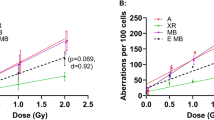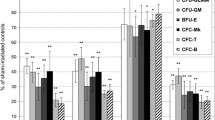Abstract
The space radiation environment consists of trapped particle radiation, solar particle radiation, and galactic cosmic radiation (GCR), in which protons are the most abundant particle type. During missions to the moon or to Mars, the constant exposure to GCR and occasional exposure to particles emitted from solar particle events (SPE) are major health concerns for astronauts. Therefore, in order to determine health risks during space missions, an understanding of cellular responses to proton exposure is of primary importance. The expression of DNA repair genes in response to ionizing radiation (X-rays and gamma rays) has been studied, but data on DNA repair in response to protons is lacking. Using qPCR analysis, we investigated changes in gene expression induced by positively charged particles (protons) in four categories (0, 0.1, 1.0, and 2.0 Gy) in nine different DNA repair genes isolated from the testes of irradiated mice. DNA repair genes were selected on the basis of their known functions. These genes include ERCC1 (5′ incision subunit, DNA strand break repair), ERCC2/NER (opening DNA around the damage, Nucleotide Excision Repair), XRCC1 (5′ incision subunit, DNA strand break repair), XRCC3 (DNA break and cross-link repair), XPA (binds damaged DNA in preincision complex), XPC (damage recognition), ATA or ATM (activates checkpoint signaling upon double strand breaks), MLH1 (post-replicative DNA mismatch repair), and PARP1 (base excision repair). Our results demonstrate that ERCC1, PARP1, and XPA genes showed no change at 0.1 Gy radiation, up-regulation at 1.0 Gy radiation (1.09 fold, 7.32 fold, 0.75 fold, respectively), and a remarkable increase in gene expression at 2.0 Gy radiation (4.83 fold, 57.58 fold and 87.58 fold, respectively). Expression of other genes, including ATM and XRCC3, was unchanged at 0.1 and 1.0 Gy radiation but showed up-regulation at 2.0 Gy radiation (2.64 fold and 2.86 fold, respectively). We were unable to detect gene expression for the remaining four genes (XPC, ERCC2, XRCC1, and MLH1) in either the experimental or control animals.


Similar content being viewed by others
References
Amundson SA, Fornace AJ Jr (2001) Gene expression profiles for monitoring radiation exposure. Radiat Prot Dosimetry 97(1):11–16
Heinloth AN, Shackelford RE, Innes CL, Bennett L, Li L, Amin RP, Sieber SO, Flores KG, Bushel PR, Paules RS (2003) Identification of distinct and common gene expression changes after oxidative stress and gamma and ultraviolet radiation. Mol Carcinog 37:65–82
Amundson SA, Do KT, Shahab S, Bittner M, Meltzer P, Trent J, Fornace AJ Jr (2000) Identification of potential mRNA biomarkers in peripheral blood lymphocytes for human exposure to ionizing radiation. Radiat Res 154(3):342–346
Jensen RH, Bigbee WL, Langlois RG (1990) Multiple endpoints for somatic mutations in humans provide complementary views for biodosimetry, genotoxicity and health risks. Prog Clin Biol Res 340C:81–92
Maity A, Kao GD, Muschel RJ, McKenna WG (1997) Potential molecular targets for manipulating the radiation response. Int J Radiat Oncol Biol Phys 37(3):639–653
Zhang Y, Clementc J, Gridleyd D, Rodhe L, Honglu W (2009) Protein expression profile changes in human fibroblasts induced by low dose energetic protons. Adv Space Res 44(12):1450–1456
NCRP (1989) Guidance on radiation received in space activities (Report 98). National Council on Radiation Protection and Measurements, Bethesda, MD
Wilson JW, Clowdsley MS, Cucinotta FA, Tripathi RK, Nealy JE, De Angelis G (2004) Deep space environments for human exploration. Adv Space Res 34(6):1281–1287
Gridley DS, Coutrakon GB, Rizvi A, Bayeta EJ, Luo-Owen X, Makinde AY, Baqai F, Koss P, Slater JM, Pecaut MJ (2008) Low-dose photons modify liver response to simulated solar particle event protons. Radiat Res 169(3):280–287
Chaudhry MA (2008) Biomarkers for human radiation exposure. J Biomed Sci 15(5):557–563
Jaroudi S, Kakourou G, Cawood S, Doshi A, Ranieri DM, Serhal P, Harper JC, SenGupta SB (2009) Expression profiling of DNA repair genes in human oocytes and blastocysts using microarrays. Hum Reprod 24(10):2649–2655
Oftedal P (1991) Biological low-dose radiation effects. Mutat Res 258(2):191–205
Breen AP, Murphy JA (1995) Reactions of oxyl radicals with DNA. Free Radic Biol Med 18(6):1033–1077
Szumiel I (2008) Intrinsic radiation sensitivity: cellular signaling is the key. Radiat Res 169(3):249–258
Branzei D, Foiani M (2008) Regulation of DNA repair throughout the cell cycle. Nat Rev Mol Cell Biol 9(4):297–308
Lisby S, Gniadecki R, Wulf HC (2005) UV-induced DNA damage in human keratinocytes: quantitation and correlation with long-term survival. Exp Dermatol 14(5):349–355
Taki K, Wang B, Nakajima T, Wu J, Ono T, Uehara Y, Matsumoto T, Oghiso Y, Tanaka K, Ichinohe K, Nakamura S, Tanaka S, Magae J, Kakimoto A, Nenoi M (2009) Microarray analysis of differentially expressed genes in the kidneys and testes of mice after long-term irradiation with low-dose-rate gamma-rays. J Radiat Res (Tokyo) 50(3):241–252
Huber PE (2002) Expression profiling of irradiated human lung endothelial cells using large DNA chip. Int J Radiat Oncol Biol Phys 54:24–25
Taniguchi K, Kajiyama T, Kambara H (2009) Quantitative analysis of gene expression in a single cell by qPCR. Nat Methods 6(7):503–506
Rasoulpour RJ, Boekelheide K (2007) NF-kappaB activation elicited by ionizing radiation is proapoptotic in testis. Biol Reprod 76(2):279–285
Kurn N, Chen P, Heath JD, Kopf-Sill A, Stephens KM, Wang S (2005) Novel isothermal, linear nucleic acid amplification systems for highly multiplexed applications. Clin Chem 51(10):1973–1981
Livak KJ, Schmittgen TD (2001) Analysis of relative gene expression data using real-time quantitative PCR and the 2(-Delta Delta C(T)) method. Methods 25(4):402–408
Shea MA, Smart DF (1994) Significant proton events of solar cycle 22 and a comparison with events of previous solar cycles. Adv Space Res 14(10):631–638
Smart DF, Shea MA (2002) A review of solar proton events during the 22nd solar cycle. Adv Space Res 30(4):1033–1044
Camenisch U, Nageli H (2008) XPA gene, its product and biological roles. Adv Exp Med Biol 637:28–38
Cleaver JE, Charles WC, McDowell ML, Sadinski WJ, Mitchell DL (1995) Overexpression of the XPA repair gene increases resistance to ultraviolet radiation in human cells by selective repair of DNA damage. Cancer Res 55(24):6152–6160
Zhang Y, Rohde LH, Wu H (2009) Involvement of nucleotide excision and mismatch repair mechanisms in double strand break repair. Curr Genomics 10(4):250–258
Schreiber V, Ame JC, Dolle P, Schultz I, Rinaldi B, Fraulob V, Menissier-de Murcia J, de Murcia G (2002) Poly(ADP-ribose) polymerase-2 (PARP-2) is required for efficient base excision DNA repair in association with PARP-1 and XRCC1. J Biol Chem 277(25):23028–23036
Shall S, de Murcia G (2000) Poly(ADP-ribose) polymerase-1: what have we learned from the deficient mouse model? Mutat Res 460(1):1–15
Herceg Z, Wang ZQ (2001) Functions of poly(ADP-ribose) polymerase (PARP) in DNA repair, genomic integrity and cell death. Mutat Res 477(1–2):97–110
Wieler S, Gagne JP, Vaziri H, Poirier GG, Benchimol S (2003) Poly(ADP-ribose) polymerase-1 is a positive regulator of the p53-mediated G1 arrest response following ionizing radiation. J Biol Chem 278(21):18914–18921
Fernet M, Ponette V, Deniaud-Alexandre E, Menissier-De Murcia J, De Murcia G, Giocanti N, Megnin-Chanet F, Favaudon V (2000) Poly(ADP-ribose) polymerase, a major determinant of early cell response to ionizing radiation. Int J Radiat Biol 76(12):1621–1629
Pandita TK, Lieberman HB, Lim DS, Dhar S, Zheng W, Taya Y, Kastan MB (2000) Ionizing radiation activates the ATM kinase throughout the cell cycle. Oncogene 19(11):1386–1391
Fang ZM, Lee CS, Sarris M, Kearsley JH, Murrell D, Lavin MF, Keating K, Clarke RA (2001) Rapid radiation-induction of ATM protein levels in situ. Pathology 33(1):30–36
Aguilar-Quesada R, Muñoz-Gámez JA, Martín-Oliva D, Peralta A, Valenzuela MT, Matínez-Romero R, Quiles-Pérez R, Murcia JM, de Murcia G, Ruiz de Almodóvar M, Oliver FJ (2007) Interaction between ATM and PARP-1 in response to DNA damage and sensitization of ATM deficient cells through PARP inhibition. BMC Mol Biol 8:29
Canman CE, Lim DS, Cimprich KA, Taya Y, Tamai K, Sakaguchi K, Appella E, Kastan MB, Siliciano JD (1998) Activation of the ATM kinase by ionizing radiation and phosphorylation of p53. Science 281(5383):1677–1679
Cheng L, Guan Y, Li L, Legerski RJ, Einspahr J, Bangert J, Alberts DS, Wei Q (1999) Expression in normal human tissues of five nucleotide excision repair genes measured simultaneously by multiplex reverse transcription-polymerase chain reaction. Cancer Epidemiol Biomarkers Prev 8(9):801–807
Vogel U, Dybdahl M, Frentz G, Nexo BA (2000) DNA repair capacity: inconsistency between effect of over-expression of five NER genes and the correlation to mRNA levels in primary lymphocytes. Mutat Res 461(3):197–210
Li Q, Yu JJ, Mu C, Yunmbam MK, Slavsky D, Cross CL, Bostick-Bruton F, Reed E (2000) Association between the level of ERCC-1 expression and the repair of cisplatin-induced DNA damage in human ovarian cancer cells. Anticancer Res 20(2A):645–652
Yacoub A, McKinstry R, Hinman D, Chung T, Dent P, Hagan MP (2003) Epidermal growth factor and ionizing radiation up-regulate the DNA repair genes XRCC1 and ERCC1 in DU145 and LNCaP prostate carcinoma through MAPK signaling. Radiat Res 159(4):439–452
Ahmad A, Robinson AR, Duensing A, van Drunen E, Beverloo HB, Weisberg DB, Hasty P, Hoeijmakers JH, Niedernhofer LJ (2008) ERCC1-XPF endonuclease facilitates DNA double-strand break repair. Mol Cell Biol 28(16):5082–5092
Liu N, Lamerdin JE, Tebbs RS, Schild D, Tucker JD, Shen MR, Brookman KW, Siciliano MJ, Walter CA, Fan W, Narayana LS, Zhou ZQ, Adamson AW, Sorensen KJ, Chen DJ, Jones NJ, Thompson LH (1998) XRCC2 and XRCC3, new human Rad51-family members, promote chromosome stability and protect against DNA cross-links and other damages. Mol Cell 1(6):783–793
Pierce AJ, Johnson RD, Thompson LH, Jasin M (1999) XRCC3 promotes homology-directed repair of DNA damage in mammalian cells. Genes Dev 13(20):2633–2638
Zhao JR, Bai YJ, Zhang QH, Wan Y, Li D, Yan XJ (2005) Detection of hepatitis B virus DNA by real-time PCR using TaqMan-MGB probe technology. World J Gastroenterol 11(4):508–510
Zhao W, Chuang EY, Mishra M, Awwad R, Bisht K, Sun L, Nguyen P, Pennington JD, Wang TJ, Bradbury CM, Huang L, Chen Z, Bar-Sela G, Robbins ME, Gius D (2006) Distinct effects of ionizing radiation on in vivo murine kidney and brain normal tissue gene expression. Clin Cancer Res 12(12):3823–3830
Acknowledgments
This work was supported in part by grants from the National Aeronautics and Space Administration Cooperative Agreements NCC9-165 and NNX08BA47A, National Institutes of Health [P01-HG000205], the National Science Foundation [DBI 0830141].
Author information
Authors and Affiliations
Corresponding author
Additional information
An erratum to this article can be found at http://dx.doi.org/10.1007/s11010-010-0710-4
Rights and permissions
About this article
Cite this article
Tariq, M.A., Soedipe, A., Ramesh, G. et al. The effect of acute dose charge particle radiation on expression of DNA repair genes in mice. Mol Cell Biochem 349, 213–218 (2011). https://doi.org/10.1007/s11010-010-0641-0
Received:
Accepted:
Published:
Issue Date:
DOI: https://doi.org/10.1007/s11010-010-0641-0




